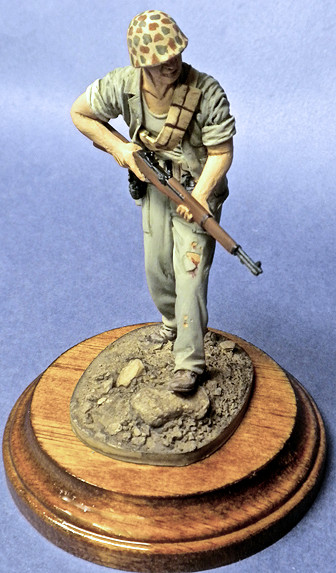
| KIT #: | 2197 |
| PRICE: | $27.00 SRP |
| DECALS: | None required |
| REVIEWER: | Blair Stewart |
| NOTES: | Resin figure |

| HISTORY |
While all warfare is brutal to the foot soldier, it is hard to argue that one of, if not the most, difficult theaters of World War II was that faced by the US Marines in the Pacific campaigns. In addition to a tough and determined Japanese enemy, Marines had to fight against the elements. Over thousands of miles of ocean, they encountered a huge variety of terrain and climate. From the tropical rain forests of the Solomon Islands to the miring volcanic wasteland of Iwo Jima, the Pacific battleground alone was a formidable foe. Marines encountered sand, stifling heat, energy-sapping humidity, every sort of insect, and poisonous snakes and other vermin. Before the war began, most Americans got their impressions of the Pacific islands from the Bob Hope & Bing Crosby Road pictures, or from the pages of the National Geographic. These led to images of balmy tropical breezes, swaying palm trees, and beautiful sandy beaches. The reality of waging war in the Pacific was dramatically different for US Marine Corps as they battled the Japanese.
Marines had to cope with blistering heat,
drenching rains, and some of the most rugged landscapes on earth. In some parts
of the Pacific, Marines faced thick tropical jungles. In the South Pacific,
Marines quickly learned that the jungle foliage hid mud, rotting vegetation,
sluggish jungle streams, and a maddening hoard of malaria-carrying mosquitoes.
World War II Marine and my personal favorite historian William Manchester
characterized the jungle in his book Goodbye Darkness
as a “vision of beauty, but of evil beauty.” He also wrote
that, while the tropical forest looked like you could walk on it, that “[i}n
reality 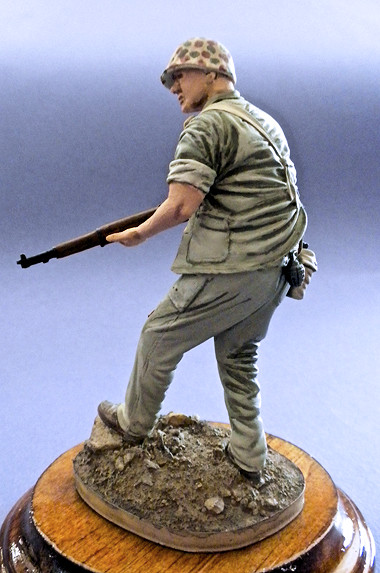 the
ground--if you could find it--lay a hundred feet below the cloying beauty of the
treetops...Here the green fastness was broken only by streams veining the
forest, flowing northward to the sea."
the
ground--if you could find it--lay a hundred feet below the cloying beauty of the
treetops...Here the green fastness was broken only by streams veining the
forest, flowing northward to the sea."
The Marine offensive presence in the Pacific Theater essentially began when the US and its allies identified that the Japanese were constructing an airfield at Guadalcanal in the Solomon Islands. Sixteen thousand Allied infantry, primarily U.S. Marines, made an amphibious landing to capture the airfield on August 7, 1942.
Over the next six months, both sides poured resources into an escalating battle of attrition on land, at sea, and in the sky. Most of the Japanese aircraft based in the South Pacific were redeployed to the defense of Guadalcanal. Meanwhile, Japanese ground forces launched repeated attacks on heavily defended US positions around Henderson Field, in which they suffered major casualties due to the determined defense by US Marines. To sustain these offensives, the Japanese used the “Tokyo Express” convoys to resupply their forces.
Strategically, possession of a Guadalcanal air base was important to control of the sea lines of communication between the United States and Australia. While the battle for Guadalcanal was fought on land, at sea and in the air, what stood out was the resolve and resourcefulness of the U.S. Marines, whose tenacious defense of the air base dubbed Henderson Field enabled the Americans to secure air superiority.
By the end of the battle on February 9, 1943, the Japanese had lost two-thirds of the 31,400 army troops it had committed to the island, while the U.S. Marines and the U.S. Army had lost less than 2,000 men out of about 60,000 deployed. The ship losses on both sides were especially heavy. But by far the most significant loss for the Japanese was the decimation of their elite group of naval aviators. After Guadalcanal, Japan no longer had any realistic hope of prevailing against the counteroffensive of an increasingly powerful United States.
By now, the US and its allies had some momentum in the Pacific Theater, and 1943 saw a marked increase in the US offensive tempo. In November, US Marines invaded Bougainville in the Solomon Islands. But the most famous Marine battle of late 1943 began on November 20 when the Marines invaded Betio Island in the Tarawa Atoll, which was part of the Gilbert Islands. Betio was heavily fortified and defended by some 5,000 Japanese of their elite Special Navy Landing Forces. Admiral Shibasaki, commander of this force, boasted “the Americans could not take Tarawa with a million men in a hundred years.” Despite a number of events that would later prove deadly to the Marine landing force (e.g., an early halt to the naval bombardment, landing the Marines at a low tide level, which forced Marines to wade ashore from several hundred yards away, murderous fire from the defending force that had managed to survive the pre-invasion bombardment, poor communications, etc.) the Marine force made it to shore and, by afternoon, had established a toehold on parts of Red Beaches 2 and 3. Marines in the initial wave of amtracs and those who were forced to wade ashore suffered heavy (decimating) casualties as a result of a fierce Japanese defense.
By the morning of November 25, the entire Japanese garrison on the island – save for 17 prisoners - was dead. The Marines suffered some 3,133 casualties with the majority, 2,186, being wounded in action. In addition, there were four medals of honor awarded to Marines at Tarawa for their heroic actions during the battle.
The allied advance in the Pacific continued into 1944,
and Marines found themselves engaged the invasions of Saipan in June and Guam
and Tinian in July. In January 1945, the allies began preparing for the
invasions of Iwo Jima, Okinawa, and Japan. Iwo Jima was deemed a vital target as
it was an obstacle t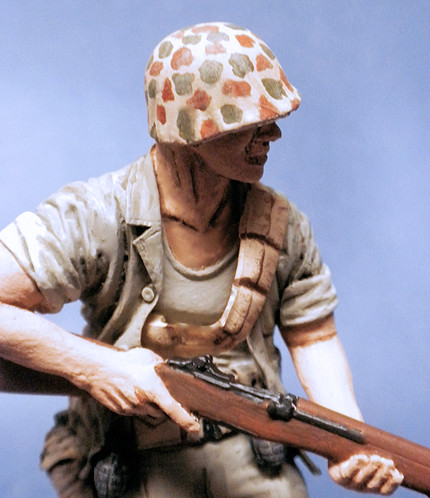 o
B-29 forces on their way to bomb Japan – both in terms of fighter attacks and
providing up to two hours of warning against raids launched from Saipan, Tinian
and Guam.
o
B-29 forces on their way to bomb Japan – both in terms of fighter attacks and
providing up to two hours of warning against raids launched from Saipan, Tinian
and Guam.
On February 19, 70,000 Marines of the 3rd, 4th, and 5th Marine Divisions, under the command of Lt. Gen. Holland “Howlin Mad” Smith, began what would essentially be their last major “autonomous” landing operation of the war against Iwo Jima (the Marines were later a key part of the horrific battle for Okinawa, but they were under the command of the US 10th Army, and their killed-in-action [KIA] casualties would be about a half of what they were on Iwo Jima). Opposing the Marines on Iwo were some 21,000 Japanese under the command of Lt. Gen. Tadamichi Kuribayashi.
The American invasion plan called for landing the Marines on a two-mile stretch of beach between Mount Suribachi and the East Boat Basin on the island’s southeast coast. One regiment of the landing force would then move straight across the island, cutting off and then securing Mount Suribachi. Another regiment would cross the island and move north, while yet another would seize the first of two airfields, and then move north to seize the second. Finally, a fourth regiment, deployed on the extreme right of the invasion force, would neutralize the high ground around the Quarry that overlooked the East Boat Basin.
On the Japanese side, the crux of the defensive plan was a massive array of underground defenses, joined by a series of tunnels. Having studied other battles in the Pacific, Kuribayashi concluded that he could not succeed by stopping the Americans on the beaches; rather, he opted to wage a prolonged battle of attrition. Even though he knew the Americans would prevail, he planned to inflict as many Marine casualties as possible before they did. The geography of the island essentially dictated the landing sites for the invasion force. The Japanese understood this and planned their defensive fire accordingly.
D-Day for the invasion was preceded by three days of naval bombardment (the Marines had requested 10), and shortly after the Marines landed, it became obvious that the naval bombardment had once again been essentially ineffective. The Marines met light resistance as they poured ashore, but they quickly discovered that the black volcanic sand on the island was a formidable obstacle. As they bogged down in the sand, Marines began shedding various pieces of personal equipment – anything but weapons and ammunition – to help them move forward from the landing beaches.
As the first wave tried to move forward off the beaches, following waves landed behind them every five minutes, and soon the beaches became a lucrative target for Gen. Kuribayashi’s forces. He ordered his forces to commence firing, and they began laying down a torrent of artillery and machine gun fire from all over the island onto the crowded beaches. Shortly thereafter, the control ship USS Eldorado began receiving frantic messages such as: “troops 200 yds inland pinned down;” catching all hell from the Quarry;” and “machine gun and artillery fire heaviest ever seen.”
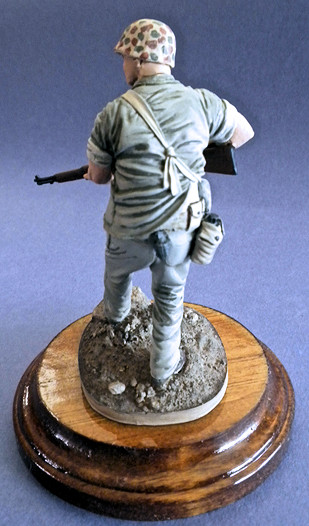 After two
days (D+1), the Marines had control of almost a fourth of the island, but at a
heavy cost. As they settled in for the night, heavy rains fell and added to
their misery. Not until D+4 did the Marines capture Mount Suribachi. Still, its
capture so early in the battle was a surprise to Gen. Kuribayashi. At 1020
hours, the stars and stripes were hoisted on top of the mountain. This was the
first flag raising. At about 1200 hrs. five Marines and a Navy Corpsman raised a
larger flag, and this one, photographed by Associated Press photographer Joe
Rosenthal, became the centerpiece of one of the most famous pictures of World
War II. Of the six flag raisers, three were subsequently killed on Iwo Jima.
After two
days (D+1), the Marines had control of almost a fourth of the island, but at a
heavy cost. As they settled in for the night, heavy rains fell and added to
their misery. Not until D+4 did the Marines capture Mount Suribachi. Still, its
capture so early in the battle was a surprise to Gen. Kuribayashi. At 1020
hours, the stars and stripes were hoisted on top of the mountain. This was the
first flag raising. At about 1200 hrs. five Marines and a Navy Corpsman raised a
larger flag, and this one, photographed by Associated Press photographer Joe
Rosenthal, became the centerpiece of one of the most famous pictures of World
War II. Of the six flag raisers, three were subsequently killed on Iwo Jima.
The battle for Iwo Jima would continue for another 32 days- until March 26, when the Marines stopped a last ditch attack from some 200-300 Japanese troops. It would result in some of the highest casualty figures in the history of the US Marine Corps. At the battle’s end, 6,821 American fighting men had been killed – 5,931 of them US Marines. The wounded and combat fatigue casualties accounted for another 21,865 servicemen, bringing the total US casualty figure to 28,686. Of the 21,000 Japanese defenders, over 20,000 were killed.
One final note: 27 medals of honor were awarded for bravery at Iwo Jima, a figure that represents a third of the total number of awards to members of the USMC during the whole of World War II. This led to Admiral Nimitz’ famous tribute, later to be inscribed on the base of the Marine Corps Memorial at the northern end of Arlington National Cemetery: “Uncommon valor was a common virtue.”
| THE KIT |
The figure is one in a long line of finely detailed 120mm cast resin military figures by Verlinden Productions. When completed, the figure strikes a “ready” pose that superbly captures one’s vision of the essence of a US Marine engaged in heavy fighting in the Pacific Theater.
As is typical of these figures, the kit comes in 12 separate parts and parts attached to resin casting blocks. The arms, torso and legs are separate components, as are the figure’s individual pieces of equipment such as canteen, grenades, ammo bandolier, helmet, and the beautifully sculpted M-1 Garand rifle. The sculpting of the figure is extremely sharp with the great detail afforded by the large 120mm scale.
An added plus is the base, which depicts rugged terrain typical of places in the Pacific that the Marines fought for and died to capture.
| CONSTRUCTION |
February 2015 marked the 60th anniversary of the USMC victory at Iwo Jima. Since surviving World War II veterans are dwindling in numbers, I thought it would be appropriate now to honor both the living and the dead who fought on Iwo Jima with this figure.
As usual, my first step was to remove the various pieces from their casting blocks and then clean them up. For the larger pieces, I use a razor saw to cut the piece off the resin block, and then use a sharp Xacto knife to clean things up. One can also use a piece of sandpaper on a flat surface to remove the final casting block resin (exercise caution in doing so: it’s easy to get carried away with the sanding and sand away more than you want).
Once I did this, I used Super Glue to assemble the torso, legs and arms. When these were dry, I glued the figure to a wood block to facilitate handling the model during the painting process.
| COLORS & MARKINGS |
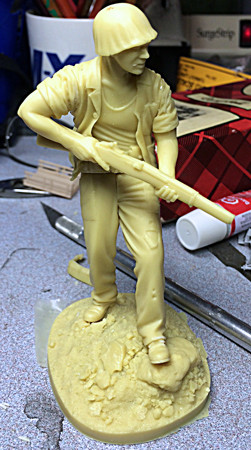 My first
step was to spray paint the figure with Testors flat white enamel to serve as
the base coat and provide a light base for subsequent painting.
My first
step was to spray paint the figure with Testors flat white enamel to serve as
the base coat and provide a light base for subsequent painting.
The next step was to hand paint the figure. For this and my other figures, I primarily used relatively inexpensive flat acrylic paints available from stores such as Walmart and Hobby Lobby.
I started out with the head. I used a darker shade of flesh tone (Apple Barrel Lite Mocha) to facilitate later detailing of the face with lighter shades of flesh tones. I then shaded various locations with darker shades of acrylic colors to highlight the figure’s exposed flesh.
Again, with figures, the major challenge is the skin tones, and then the proper shading to get some kind of expression on the face. Another challenge for this particular figure was the various shades of green in the Marine uniform, tee shirt, and equipment. For most of these areas, I started out with Vallejo German Field Grey (which is actually looks green), and then lightened or darkened the color by mixing the field grey either with flat white or burnt umber. I had to experiment on more than one occasion until I was satisfied with the shades of green making up the Marine’s clothing.
For the helmet’s camouflage cover, I first painted the whole cover with Craft Smart tan, then used Craft Smart olive green and Americana burnt sienna to create the splotches on the cover.
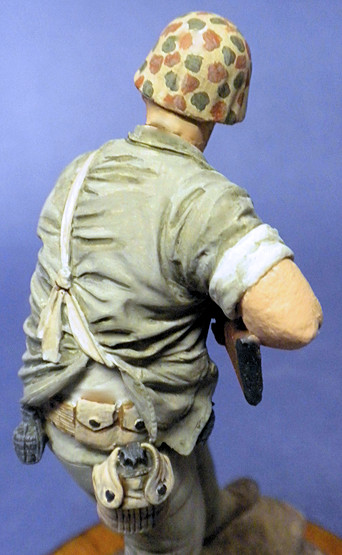 For the
M-1 rifle, I painted the wood stock with burnt umber, and then used Testors
enamel gun metal for the rifle’s barrel, operating rod, receiver, trigger guard,
stock rings, and butt stock. I also used the gunmetal paint for the hand
grenades hanging from the figure’s canvas utility belt. For the belt, I started
with the tan I used for the helmet cover, then mixed various colors with it
until I was satisfied with the shading. I painted the Marine’s leather boots
using Americana burnt umber, and then dry brushed them with the Smart Craft tan.
For the
M-1 rifle, I painted the wood stock with burnt umber, and then used Testors
enamel gun metal for the rifle’s barrel, operating rod, receiver, trigger guard,
stock rings, and butt stock. I also used the gunmetal paint for the hand
grenades hanging from the figure’s canvas utility belt. For the belt, I started
with the tan I used for the helmet cover, then mixed various colors with it
until I was satisfied with the shading. I painted the Marine’s leather boots
using Americana burnt umber, and then dry brushed them with the Smart Craft tan.
Once I had painted everything, I mixed some darker shade paint and then used this to highlight folds in the figure’s uniform. I also painted the rolled up portion of the uniform sleeves a lighter shade of field grey to replicate the “inside out” hue of military fatigues.
After the figure dried, I super glued it to its resin base, and then painted the base with the Craft Smart tan. Once dried, I treated the base with a wash of acrylic black paint to highlight the rocks and sand.
Even though the figure already had a resin base, I wanted to mount the entire model on a wooden base, so I bought a pre-made wooden circular one from Hobby Lobby. I stained the base with Watco oil, and, when it was dry, coated it with numerous coats of Rustoleum Gloss Crystal Clear out of a rattle can to get a high gloss finish. Once the wooden base was dry, I glued the figure and its base to it.
| CONCLUSIONS |
Once again, Verlinden comes through with a great looking figure of the primary bearer of warfare: the ordinary grunt/foot soldier who must fight it out to the end in the worst imaginable conditions. The US Marines have to be some of the most unsung heroes of World War II, and those who fought so valiantly and long on Iwo Jima certainly earned their place in America’s military history. If you are into military or other figures, I highly recommend this kit. The figure is a small “salute” to the US Marines who fought and won the Pacific campaign against the Japanese during World War II.
| REFERENCES |
World War 2 Gyrene, World Wide Web, December 2015.
The Pacific War, Wikipedia, December 2015.
Battle of Guadalcanal, History Channel Website, December 2015.
Derrick Wright, “Tarawa 1943: The Turning of the Tide,” Osprey Publishing Ltd., Great Britain, 2000.
Derrick Wright, “Iwo Jima 1945: The Marines Raise the Flag on Mount Suribachi,” Osprey Publishing Ltd., Great Britain, 2001.
Richard F. Newcomb, “Iwo Jima,” Bantam Books, New York, NY, July 1982.
January 2016
Copyright ModelingMadness.com
If you would like your product reviewed fairly and fairly quickly, please contact the editor or see other details in the Note to Contributors.